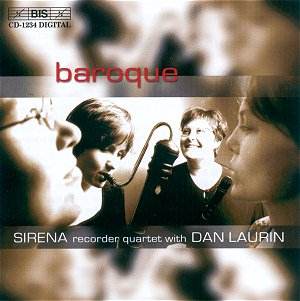During
the period we call ‘baroque’ the recorder was losing ground, being
increasingly pushed onto the sidelines by the transverse flute.
A clear sign of this trend was the publication of Vivaldi’s opus
10, around 1728 in Amsterdam. Originally two of the six concertos
were composed for the recorder, but when they were published as
part of opus 10, all the solo parts were for the transverse flute.
And although Johann Sebastian Bach regularly used recorders in
his vocal works, he never composed any solo pieces for the instrument.
The
recorder held its popularity, though, in circles of amateurs:
the instrument was played well into the 19th century. It is no
coincidence that it was Telemann who, as one of the few composers
of the 18th century, wrote quite a number of pieces for the recorder.
He had a good feeling for the demands of amateur musicians.
No
wonder many of today’s recorder players look for an extension
of the repertoire for their instrument. They often play music
originally composed for other instruments, like the violin. For
an ensemble of recorders it is even harder to find appropriate
music, since the phenomenon of the recorder consort vanished during
the 17th century – except in England. The Swedish recorder quartet
Sirena has done what solo recorder players do: they have arranged
music for other instruments for their consort – with mixed success.
Let
me start with what is the most satisfying part of this recording:
the Concertos for 4 treble recorders and basso continuo by the
German composer Johann Christian Schickhardt. Although he – like
Telemann and Boismortier – composed a great number of works, he
never reached the status of someone like Telemann, who – thanks
to the printing licence he acquired – could publish a large number
of works and earn quite a lot of money. Schickhardt’s works are
quite unique because of their scoring for 4 treble recorders with
basso continuo. He is strongly influenced by the Italian style
and his concertos are very lively and idiomatic for the instruments.
Where
in Schickhardt's Concertos the recorders are treated equally and
the motifs wander from one part to the other, Boismortier uses
the instruments regularly as a kind of ‘orchestra’. In his Concertos
op. 15, which were originally composed for 5 transverse flutes,
passages for one or two flutes are interspersed by ‘tutti’. This
is the main reason the performance on recorders doesn’t work very
well. The sound is very massive and static: five flutes playing
together can have a wonderful effect, as the recording of these
concertos by members of the Concert Spirituel (Naxos) proves.
The dynamic differentiation in that recording is lacking here,
partly because of the way the ensemble plays, but even more so
because of the limited dynamic possibilities of the recorder.
The Sonatas from opus 34 are much better. Since the title of opus
34 suggests a performance by transverse flutes, violins or other
instruments, Boismortier may have avoided everything that was
too idiomatic for a particular kind of instrument.
Telemann’s
Concertos are another example of pieces that are not very convincing
on instruments other than violins. The most striking example is
the Concerto in E, where the ‘principal’ recorder regularly has
to play an octave lower than notated, since the recorder’s compass
is smaller than that of the violin. But this just undermines the
intentions of the composer and changes the whole character of
the work.
It
would have been nice if Sirena had recorded all six Concertos
by Schickhardt: these are delightful works, which deserve to be
played and recorded, and since there is no complete recording
in the catalogue, such a recording would have been most welcome.
I
have somewhat mixed feelings about this recording: the ensemble
is excellent, no doubt about it, but it has been a bit unlucky
in its choice of repertoire. As far as the interpretation is concerned,
I would have wished for a little more imagination and boldness.
Johan
van Veen

